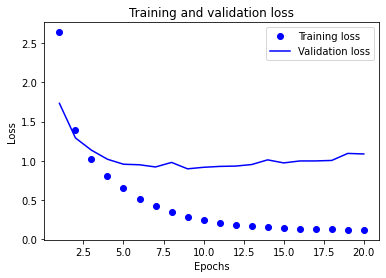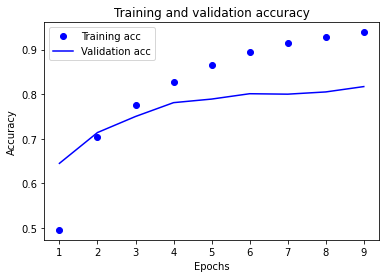简介
本例出自《Python 深度学习》,自己做了一个简单的总结归纳。
完整代码请参考:[https://github.com/fchollet/deep-learning-with-python-notebooks](
数据预处理
训练模型
(因为是用mermaid写的流程图,看着有点小,可以放大网页查看)
代码
加载数据集
注意:第一次运行会下载数据集,速度较慢。
复制代码
1
2
3
4
5from keras.datasets import reuters (train_data, train_label), (test_data, test_label) = reuters.load_data(num_words=10000)
将向量还原为原始新闻(非必须)
执行这一步只是为了更直观的了解别人是怎么处理数据的。
这里同样会下载数据。
复制代码
1
2
3
4
5word_index = reuters.get_word_index() reverse_word_index = dict([(value, key) for (key, value) in word_index.items()]) decoded_newswire = ' '.join([reverse_word_index.get(i-3, '?') for i in train_data[0]]) print(decoded_newswire)
将数据向量化
复制代码
1
2
3
4
5
6
7
8
9
10
11
12import numpy as np # 数据向量化 def vectorize_sequences(sequences, dimension=10000): results = np.zeros((len(sequences), dimension)) for i, sequence in enumerate(sequences): results[i, sequence] = 1. return results x_train = vectorize_sequences(train_data) x_test = vectorize_sequences(test_data)
使用 one-hot 编码将标签向量化
复制代码
1
2
3
4
5
6
7
8
9
10
11
12
13# one-hot编码方法实现 # def to_one_hot(labels, dimension=10000): # results = np.zeros((len(labels), dimension)) # for i, label in enumerate(labels): # results[i, label] = 1. # return results # 使用keras内置方法将标签向量化 from keras.utils.np_utils import to_categorical one_hot_train_labels = to_categorical(train_label) one_hot_test_labels = to_categorical(test_label)
构建模型
复制代码
1
2
3
4
5
6
7
8
9
10
11
12
13
14
15
16
17
18
19
20
21
22# 定义模型 from keras import models from keras import layers model = models.Sequential() """ Q: 为什么此处输入单元数要使用64,为什么不使用电影评论分类时使用的16? A:16维空间对于这个例子来说太小了,无法学会区分46个不同的类别。 这种维度较小的层可能成为信息瓶颈,永久地丢失相关信息。 如果是三分类,四分类问题你依然可以使用16个隐藏单元 Q:我能不能设置为640个单元? A:单元数不是越大越好,网络容量越大,网络就越容易记住训练过的数据。 网络会在训练过的数据上表现优异,但是在没有见过的数据上的表现则不容乐观。 因此单元数不是越大越好,需要在欠拟合与过拟合之间找到一个平衡点。 """ model.add(layers.Dense(64, activation='relu', input_shape=(10000, ))) model.add(layers.Dense(64, activation='relu')) model.add(layers.Dense(46, activation='softmax')) # 编译模型 model.compile(optimizer='rmsprop', loss='categorical_crossentropy', metrics=['accuracy'])
验证模型
复制代码
1
2
3
4
5
6
7
8
9
10# 留出验证集 x_val = x_train[:1000] partial_x_train = x_train[1000:] y_val=one_hot_train_labels[:1000] partial_y_train = one_hot_train_labels[1000:] # 训练模型 history = model.fit(partial_x_train, partial_y_train, epochs=20, batch_size=512, validation_data=(x_val, y_val))
绘制训练情况图表
复制代码
1
2
3
4
5
6
7
8
9
10
11
12
13
14
15
16
17
18
19
20
21
22
23
24
25
26
27
28
29
30
31
32# 绘制训练损失和验证损失 import matplotlib.pyplot as plt loss = history.history['loss'] val_loss = history.history['val_loss'] epochs = range(1, len(loss)+1) plt.plot(epochs, loss, 'bo', label='Training loss') plt.plot(epochs, val_loss, 'b', label='Validation loss') plt.title('Training and validation loss') plt.xlabel('Epochs') plt.ylabel('Loss') plt.legend() # 绘制训练精度和验证精度 plt.clf() acc = history.history['accuracy'] val_acc = history.history['val_accuracy'] plt.plot(epochs, acc, 'bo', label='Training acc') plt.plot(epochs, val_acc, 'b', label='Validation acc') plt.title('Training and validation accuracy') plt.xlabel('Epochs') plt.ylabel('Accuracy') plt.legend() plt.show()


重新训练模型
观察图表,发现模型在第十轮附近出现过拟合现象。那么我们重新训练模型就训练九轮就行(可以尝试其它的)。
复制代码
1
2
3
4
5
6
7
8
9
10
11
12
13
14
15
16
17
18
19
20
21
22
23
24
25# 重新训练模型 model = models.Sequential() model.add(layers.Dense(64, activation='relu', input_shape=(10000, ))) model.add(layers.Dense(64, activation='relu')) model.add(layers.Dense(46, activation='softmax')) model.compile(optimizer='rmsprop', loss='categorical_crossentropy', metrics=['accuracy']) history = model.fit(partial_x_train, partial_y_train, epochs=9, batch_size=512, validation_data=(x_val, y_val)) # 观察在测试集上表现 results = model.evaluate(x_test, one_hot_test_labels) print(results) # [0.9868815943054715, 0.7862867116928101] # 80%左右的精度 # 采取随机预测的方式 import copy test_labels_copy = copy.copy(test_label) np.random.shuffle(test_labels_copy) hits_array = np.array(test_label) == np.array(test_labels_copy) print(float(np.sum(hits_array)) / len(test_label)) # 0.18788958147818344 # 20%的精度,可以看出模型的预测效果好得多
绘制图表观察重新训练的模型各项指标 -


小结
- 如果要对N个类别的数据点进行分类,网络的最后一层应该是大小为N的Dense层。
- 对于单标签、多分类问题,网络的最后一层应该使用 softmax 激活,这样可以输出在N个输出类别上的概率分布。
- 这种问题的损失函数几乎总是应该使用分类交叉熵。它将网络输出的概率分布与目标的真实分布之间的距离最小化。
- 如果你需要将数据划分到许多类别中,应该避免使用太小的中间层,以免在网络中造成信息瓶颈。
- 处理多分类问题的标签有两种方法。
- 通过分类编码(也叫one-hot编码)对标签进行编码,然后使用categorical_crossentropy 作为损失函数。
- 将标签编码为整数,然后使用 sparse_categorical_crossentropy 损失函数。
最后
以上就是踏实发带最近收集整理的关于新闻分类:多分类问题的全部内容,更多相关新闻分类内容请搜索靠谱客的其他文章。
本图文内容来源于网友提供,作为学习参考使用,或来自网络收集整理,版权属于原作者所有。








发表评论 取消回复